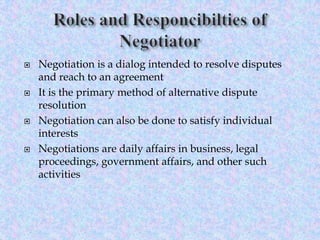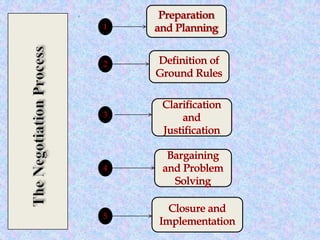Negotiation
- 2. 1-Negotiation Introduction Definition Negotiation strategies
- 3. Negotiation is a process where each party involved in negotiating tries to gain an advantage for themselves by the end of the process. Negotiation is intended to aim at compromise.
- 4. 1-ROBBINS: A process in which two or more parties exchange goods and services and attempt to agree upon the exchange rate for them. 2- KAVITA SINGH: Negotiation is a process by which two or more parties each which its own goals & perspectives coordinate areas of interest through concessions & compromise to reach an agreement and take the joint decision about areas of common concerns in a situation in which neither side has nor wants to use power.
- 5. 3- Rubin and Brown (1975) Negotiation refers to a process in which individuals work together to formulate agreements about the issues in dispute. This process assumes that the parties involved are willing to communicate and to generate offers, counteroffers, or both. Agreement occurs if and only if the offers made are accepted by both of the parties. 4- Minton( 2001) The degree to which the interests of the parties are aligned can facilitate the range and type of outcomes available for resolution.
- 6. 1-DISTRIBUTIVE NEGOTIATION The most distributive feature is that it operates under a zero sum game, that the gain made by one person is loss incurred by the other person. Each person involved in the negotiation defines ultimate point where the settlement will be made. 2-INTEGRATIVE NEGOTIATION The characteristic feature of integrative bargaining is that it relies in win-win situation and therefore uses a collaborative model of conflict resolution. Both parties involved in negotiation process jointly look at the problem, try to search for alternatives and try to evaluate them and reach a mutually acceptable decision or solution.
- 7. 1-DISTRIBUTIVE NEGOTIATION Strategies used in it are I want it all Good cop, bad cop Time wrap ultimatums 2-INTEGRATIVE NEGOTIATION Strategies used in it are Focus on interests and not position Separate the people from the problem Insist on using objective criteria Invest option for mutual gains
- 8. Importance of negotiation Roles and responsibilities of negotiators
- 9. Certainty The aim of contract negotiation is firstly to achieve certainty, to record what is being supplied, when, in what quantities and to what standard, and what are the consequences of delay or failure to meet the agreed requirements. The best deal Seeking clarity does not conflict with the view that negotiations should achieve the best deal, it merely points out that both parties to a negotiation have to understand what it is that they have agreed to. Achievement of an Organization's objectives The goal of every negotiation must be to achieve a result which, even if it falls short of the original objective, can be considered a satisfactory advancement towards it. Create of a long-term relationship between the parties Whilst this is not always possible, and some cultures, such as the Japanese, place more emphasis on this aspect of negotiation, this is increasingly important as companies build networks of alliance partners.
- 10. Negotiation is a dialog intended to resolve disputes and reach to an agreement It is the primary method of alternative dispute resolution Negotiation can also be done to satisfy individual interests Negotiations are daily affairs in business, legal proceedings, government affairs, and other such activities
- 11. Negotiation Skills and Role Distribution: A good negotiating team has members with diverse skills Technical Knowledge Relationship Skills Patience Observational Skills Behavior Analyzing Skills Having people with these qualities is a definite advantage during the process of negotiation. Depending on their skills, the members are assigned certain roles and responsibilities in the negotiation process
- 12. There are some roles and responsibilities of negotiators that can use during negotiation are; Unity within the team is the most important attribute the team should understand the subject Decide which information is needed and which is not in the process Took some points that provide help to other side try to avoid them prepared with full range of knowledge and expertise knowing the other side very well Team leader discus eith other team members such as behavior analysts, and take their feedback It is good way to solve internal disputes
- 13. Muhammad Usman Ahmed The Negotiation Process
- 14. 1 2 3 4 5
- 15. Prépare You + your team Know the other party Know the Picture Identify the objectives Priortize the objectives
- 16. Create options Select fair standards Examine Alternatives Select your strategy , tactics and counter tactics Develop a solid & approved team Negotiation plan
- 17. Introduction Détermine who has authority Rules and procedures Prepare the facility Use and agenda Create a positive working climate Exchange issues
- 18. Specify what you want Problem identification Put forward the solutions Exchange information Focus on objectives Listen carefully and question thoroughly Seek compromise: get win/win if possible Remember optimum and fallback positions
- 19. Ask for what you want:modify if you need Don`t concede without exchanging Decide on areas of possible flexibility Use stratagies ,tactics and countertactics Make counter offers Know when to walk away
- 20. Distributive Bargaining: Negotiation that seeks to divide up a fixed amount of resources : a win loose situation Integrative Bargaining : Negotiation that seeks one or more settlements that can create a win win sloution.
- 21. Statement of agreement Document the agreement Prepare Negotiation results and summary Close the remaining gaps Reach at a tentative agreement Implement the deal Monitor the implemantation
- 22. The role of personality traits in negotiation : Traits do not appear to have a significantly direct affect on the outcomes of either bargaining or negotiating process Gender Differences in Negotiations Women negotiate no differently from men, although men apparently negotiate slightly better outcomes. Men and women with similar power bases use the same negotiating styles. Women’s attitudes toward negotiation and their success as negotiators are less favorable than men’s
























